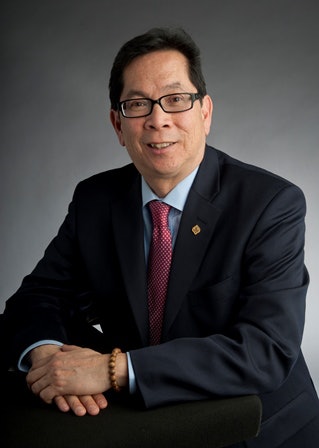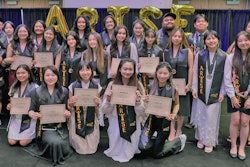 Dr. Frank Chong, president of Santa Rosa Junior College, was a panel moderator at the annual conference of the Asian Pacific Americans in Higher Education (APAHE).
Dr. Frank Chong, president of Santa Rosa Junior College, was a panel moderator at the annual conference of the Asian Pacific Americans in Higher Education (APAHE).SAN FRANCISCO — Although both of Dr. Lori Adrian’s parents were educators in their native Philippines, she still describes her college presidency as an accident of sorts. Consider her life and career path:
About three years after immigrating to the United States, Adrian found herself raising two young children alone. The single mother held a series of college administrative positions in student affairs, rather than in academics. Along the way, she finished a master’s degree in communication theory and a doctorate in education.
“Don’t let job positions define you, but pursue what you want to pursue,” said Adrian, who’s now president of Coastline Community College. Her remarks came last week during the annual conference of Asian Pacific Americans in Higher Education. Since its 1987 inception, the organization has developed programs and addressed issues impacting Asian Pacific Islander Americans. It has evolved from a group of almost exclusively Californians into one with national reach.
A former cross-cultural trainer for the U.S. Peace Corps, Adrian said her father had always empowered her to believe “you could be anything you want to be.” But she lost confidence in herself anyway during her early years in this country. When she asked an auditorium of conference-goers how many of them were immigrants, about one-third raised their hands. “Then you know what I mean,” she said, as many of them nodded.
She was among college presidents participating in a panel discussion titled, “Shattering the Myth: Asian Pacific Americans Can’t Lead.”
Nationally, only 1.5 percent of college presidents were of Asian descent in 2011, according to the American Council on Education. That figure was similar five years earlier — as well as 25 years earlier. Over the years, incumbent and former Asian-American presidents have told Diverse that their scarcity is tied in part to the so-called bamboo ceiling, a misconception that Asians aren’t assertive enough for leadership.
But at the APAHE panel discussion, Dr. Gabriel Esteban, president of Seton Hall University, recounted how he was propelled into the post even though he wasn’t a priest — a fact he reiterated to a supporter who’d approached Esteban about the presidency. Nonetheless, governing board members made an exception to the Catholic university’s bylaws and voted him president, and furthermore, he said, have since offered him a contract extension until 2018.
Ironically, Esteban didn’t start his career in teaching or working elsewhere in academia, but instead as a computer programmer. Other panelists echoed the sentiment, saying that for the most part, their paths to the top job didn’t actually involve presidencies as a goal.
Dr. Luís Calingo, president of Woodbury University, half-jokingly said he resorted to jobs in administration because he “got tired of grading 500 papers at a time” as a faculty member.
Dr. Leroy Morishita, president of California State University, East Bay, recalled his farmer father encouraging him to “do anything but farming” because of its hardscrabble nature. Morishita, who began as a college counselor in an educational opportunity program, rose to chief financial officer at San Francisco State University and sometimes butted heads with then-CSU Chancellor Charles Reed. “He would agree with that characterization, too,” Morishita said of Reed.
Still, Reed recommended Morishita for the East Bay presidency, he said.
Dr. Frank Chong, the panel moderator and president of Santa Rosa Junior College, said, “It’s safe to say these presidents were willing to take risks and try new opportunities.”
The panel of presidents encouraged conference participants aspiring to senior leadership jobs to seek mentors and not fear the possibility of failure. “It’s true that racism still exists,” said Adrian, who was a dean and vice president before becoming president. “But we have self-limiting barriers too. Don’t worry about not landing an interview. You won’t get a job if you don’t apply for it.”
Other conference speakers explored career limitations in the workplace, as well. Don Yu, a special advisor to U.S. Education Secretary Arne Duncan, said “lots of Asians” work at the Education Department, especially in upper-level GS-14 and GS-15 positions, but rarely enter the Senior Executive Service, a troubling pattern. Among his many projects, Yu has interviewed long-serving Asian-American employees at the department to determine what barriers to the SES exist and how they can be removed.
With a theme of “Our Lives, Our Stories, Our Future,” conference workshops examined challenges in academia that have been overcome, as well as those that remain. APAHE president Wyman Fong, who’s vice chancellor for human resources at the Chabot-Las Positas Community College District, noted that workshop topics ran the gamut from opportunities for women to success strategies for students who are recent immigrants.
Staff from the University of California, Los Angeles described best practices in recruitment and retention in a session titled, “Weaving a Support Network for Pacific Islander Students.” The targeted students have ancestors from Hawaii, Guam, Samoa or other islands in Polynesia, Micronesia and Melanesia. Although young people from those areas are commonly known as recruits for college sports, those targeted by UCLA are instead in the mainland for academic or other reasons.
According to the National Commission on Asian American and Pacific Islander Research in Education, about 49 percent of native Hawaiians aged 25 or older haven’t attended college at all. The numbers are worse among Guamanians and Samoans, and 58 percent of Tongans age 25 or older haven’t attended college either.
Meanwhile, UCLA officials said many of their tried-and-true practices involve a focus on family, whether it’s biological relatives or a family of classmates, friends and other allies.
At UCLA’s Pacific Islanders in Education and Retention program, staff members reach out to southern California high school students through tutoring and peer advising. The advising consists of help with college applications and writing personal statements, as well as informally mediating family disagreements.
PIER director Don Ku’uipo Hatori related the story of a local high school senior who wanted to pursue film studies and a parent who wanted him to enter the military and eventually use its educational benefits. After UCLA staff members convinced the parent to carefully consider the implications of forcing the student into the military against his will, the parent relented.
The student now plans to enroll at El Camino College.
UCLA alumna Ursula-Ann Sataga, who’s Samoan, recounted how encouragement and prodding from community college counselors motivated her to transfer to the four-year institution. As a UCLA student, she juggled classes alongside serving as director of PIER. Whenever she fell behind on any of her homework or PIER responsibilities, a UCLA counselor, whom she visited twice-monthly, would reprimand her.
“That type of accountability was a big help,” said Sataga, who began graduate studies after finishing at UCLA.
Mattie Kamahana Varner, project director for UCLA’s Retention of American Indians Now, said her program serves not only American Indian students, but also Pacific Islanders because both populations are scant on the campus of 27,000-plus undergraduates.
Data on Pacific Islanders is hard to come by because it’s often lumped with that of Asian-Americans, but the retention program has 20 Pacific Islander undergraduates, she said. Program components include peer counseling, mentoring and wellness initiatives. The latter consists of organized basketball games or volleyball matches on Friday nights, as well as monthly visits with an off-campus spiritual advisor.
The UCLA program, believed to be the first of its kind nationally, boasts nearly 100 percent retention of Pacific Islanders, she said, adding, “With students advocating for each other, they’re not going to let each other fail.”



















